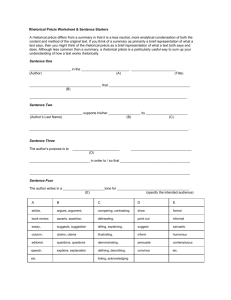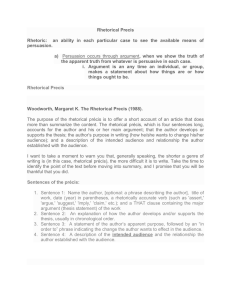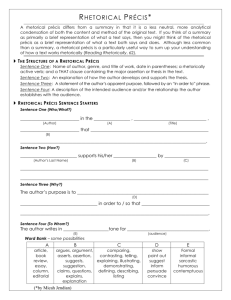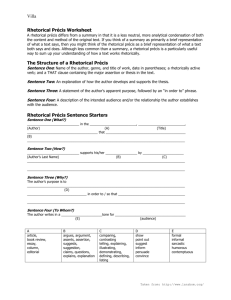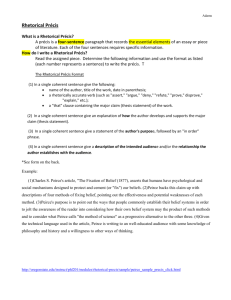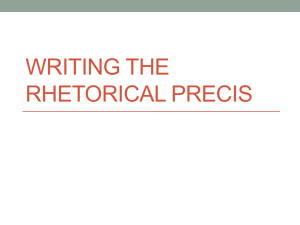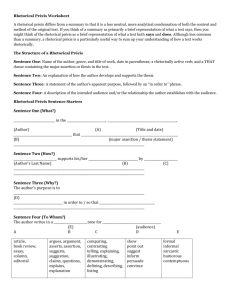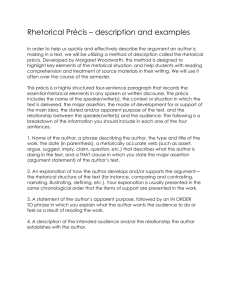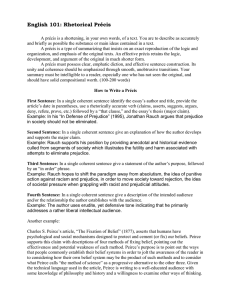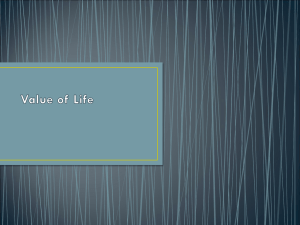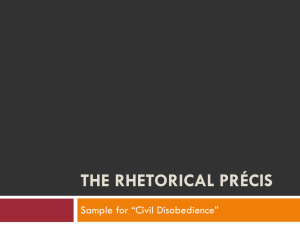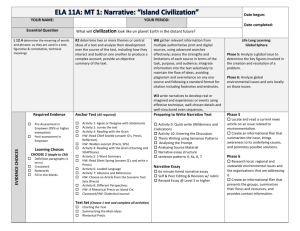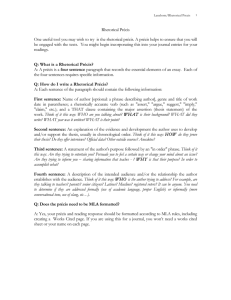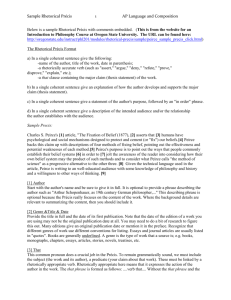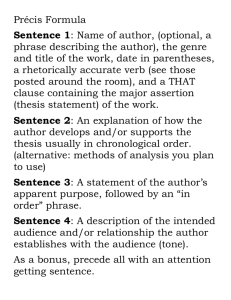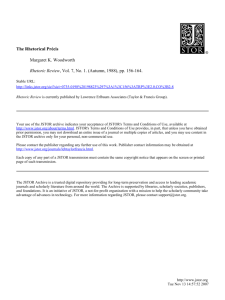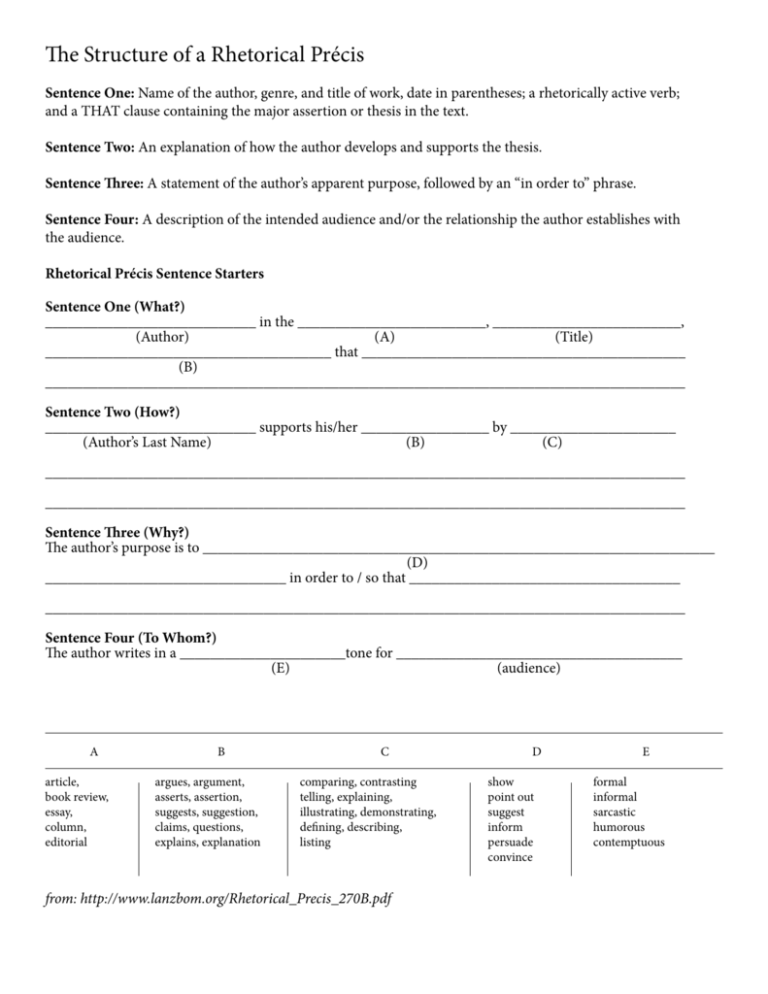
The Structure of a Rhetorical Précis
Sentence One: Name of the author, genre, and title of work, date in parentheses; a rhetorically active verb;
and a THAT clause containing the major assertion or thesis in the text.
Sentence Two: An explanation of how the author develops and supports the thesis.
Sentence Three: A statement of the author’s apparent purpose, followed by an “in order to” phrase.
Sentence Four: A description of the intended audience and/or the relationship the author establishes with
the audience.
Rhetorical Précis Sentence Starters
Sentence One (What?)
____________________________ in the _________________________, _________________________,
(Author) (A) (Title)
______________________________________ that ___________________________________________
(B)
_____________________________________________________________________________________
Sentence Two (How?)
____________________________ supports his/her _________________ by ______________________
(Author’s Last Name) (B) (C)
_____________________________________________________________________________________
_____________________________________________________________________________________
Sentence Three (Why?)
The author’s purpose is to ____________________________________________________________________
(D)
________________________________ in order to / so that ____________________________________
_____________________________________________________________________________________
Sentence Four (To Whom?)
The author writes in a ______________________tone for ______________________________________
(E) (audience)
A
article,
book review,
essay,
column,
editorial
B
argues, argument,
asserts, assertion,
suggests, suggestion,
claims, questions,
explains, explanation
C
comparing, contrasting
telling, explaining,
illustrating, demonstrating,
defining, describing,
listing
from: http://www.lanzbom.org/Rhetorical_Precis_270B.pdf
D
show
point out
suggest
inform
persuade
convince
E
formal
informal
sarcastic
humorous
contemptuous
Rhetorical Précis – Description and Examples
More Samples
I
In her article "Who Cares if Johnny Can't Read?" (1997), Larissa MacFarquhar asserts that Americans are
reading more than ever despite claims to the contrary and that it is time to reconsider why we value reading
so much, especially certain kinds of "high culture" reading. MacFarquhar supports her claims about American
reading habits with facts and statistics that compare past and present reading practices, and she challenges
common assumptions by raising questions about reading's instrisic value. Her purpose is to dispel certain
myths about reading in order to raise new and more important questions about the value of reading and other
media in our culture. She seems to have a young, hip, somewhat irreverent audience in mind because her tone
is sarcastic, and she suggests that the ideas she opposes are old-fashioned positions.
from Bean, John C., Virginia A. Chappell, and Alice M. Gillam. Reading Rhetorically, Brief Edition. New York:
Pearson/Longman, 2004. p. 63.
n order to help us quickly and effectively describe the argument an author is making in a text, we will be
utilizing a method of description called the rhetorical précis. Developed by Margaret Woodworth, this
method is designed to highlight key elements of the rhetorical situation, and help students with reading
comprehension and treatment of source materials in their writing.
This précis is a highly structured four-sentence paragraph that records the essential rhetorical elements in any
spoken or written discourse. The précis includes the name of the speaker/writer(s), the context or situation in
which the text is delivered, the major assertion, the mode of development for or support of the main idea, the
stated and/or apparent purpose of the text, and the relationship between the speaker/writer(s) and the audience. The following is a breakdown of the information you should include in each one of the four sentences.
1. Name of the author, a phrase describing the author, the type and title of the work, the date (in parenthesis),
a rhetorically accurate verb (such as “assert,” “argue,” “suggest,” “imply,” “claim,” “question,” etc.) that describes
what the author is doing in the text, and a THAT clause in which you state the major assertion (argument
statement) of the author’s text.
2. An explanation of how the author develops and/or supports the argument—the rhetorical structure of the
text (for instance, comparing and contrasting, narrating, illustrating, defining, etc.). Your explanation is usually presented in the same chronological order that the items of support are presented in the work.
3. A statement of the author’s apparent purpose, followed by an IN ORDER TO phrase in which you explain
what the author wants the audience to do or feel as a result of reading the work.
4. A description of the intended audience and/or the relationship the author establishes with the author.
Example: British philosopher, John Stuart Mill, in his essay “On Nature” (1850), argues that using nature as
a standard for ethical behavior is illogical. He supports this claim by first giving the common definitions
as nature as, “all that exists or all that exists without the intervention of man” and then supplying extensive
examples of the daily brutality of nature in the real world. His purpose is to call attention to the flaws in
the “nature as a standard” argument in order to convince people to discard this standard and to instead use
reason and logic to determine the appropriate ethical standard of action for mankind. He establishes a formal, scholarly tone for the reader of “Nature”—an audience of philosophers, educators, and other interested
citizens.
from: www.wuhsd.org/cms/lib/ca01000258/centricity/.../rhetorical_precis.doc
Toni Morrison, in her essay "Disturbing Nurses and the Kindness of Sharks," implies that racism in the United
States has affected the craft and process of American novelists. Morrison supports her implication by describing how Ernest Hemingway writes about black characters in his novels and short stories. Her purpose is
to make her readers aware of the cruel reality of racism underlying some of the greatest works of American
literature in order to help them examine the far-reaching effects racism has not only on those discriminated
against but also on those who discriminate. She establishes a formal and highly analytical tone with her audience of racially mixed (but probably mainly white), theoretically sophisticated readers and critical interpreters
of American literature.
from http://www.wam.umd.edu/~sapinoso/precis.htm
Sandra M. Gilbert, professor of English at the University of California, Davis, in her essay “Plain Jane’s Progress” (1977), suggests that Charlotte Brontë intended Jane Eyre to resemble John Bunyan’s Pilgrim’s Progress
in that Jane’s pilgrimage through a series of events based on the enclosure and escape motif eventually lead
toward the equality that Brontë herself sought. Gilbert supports this conclusion by using the structure of the
novel to highlight the places Jane has been confined, the changes she undergoes during the process of escape,
and the individuals and experiences that lead to her maturation concluding that "this marriage of true minds
at Ferndean – this is the way" (501). Her purpose is to help readers see the role of women in Victorian England in order to help them understand the uniqueness and daring of Brontë’s work. She establishes a formal
relationship with her audience of literary scholars interested in feminist criticism who are familiar with the
work of Brontë, Bunyan, Lord Byron and others and are intrigued by feminist theory as it relates to Victorian
literature.
from http://www.winthrop.edu/english/core/success/precis.htm
Charles S. Peirce's article, "The Fixation of Belief " (1877), asserts that humans have psychological and social
mechanisms designed to protect and cement (or "fix") our beliefs. Peirce backs this claim up with descriptions of four methods of fixing belief, pointing out the effectiveness and potential weaknesses of each method.
Peirce's purpose is to point out the ways that people commonly establish their belief systems in order to jolt
the awareness of the reader into considering how their own belief system may the product of such methods
and to consider what Peirce calls "the method of science" as a progressive alternative to the other three. Given
the technical language used in the article, Peirce is writing to an well-educated audience with some knowledge
of philosophy and history and a willingness to other ways of thinking.
from http://oregonstate.edu/instruct/phl201/modules/rhetorical-precis/sample/peirce_sample_precis_click.html

